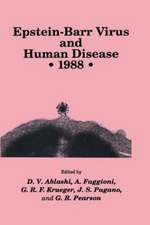Epstein-Barr Virus and Associated Diseases: Proceedings of the First International Symposium on Epstein-Barr Virus-Associated Malignant Diseases (Loutraki, Greece—September 24–28, 1984): Developments in Medical Virology, cartea 1
Editat de P. H. Levine, D.V. Ablashi, G.R. Pearson, S.D. Kottaridisen Limba Engleză Paperback – 5 oct 2011
Preț: 412.02 lei
Nou
Puncte Express: 618
Preț estimativ în valută:
78.85€ • 80.75$ • 65.59£
78.85€ • 80.75$ • 65.59£
Carte tipărită la comandă
Livrare economică 19 martie-02 aprilie
Preluare comenzi: 021 569.72.76
Specificații
ISBN-13: 9781461296416
ISBN-10: 1461296412
Pagini: 712
Ilustrații: XVI, 694 p.
Dimensiuni: 155 x 235 x 37 mm
Greutate: 0.98 kg
Ediția:Softcover reprint of the original 1st ed. 1985
Editura: Springer Us
Colecția Springer
Seria Developments in Medical Virology
Locul publicării:New York, NY, United States
ISBN-10: 1461296412
Pagini: 712
Ilustrații: XVI, 694 p.
Dimensiuni: 155 x 235 x 37 mm
Greutate: 0.98 kg
Ediția:Softcover reprint of the original 1st ed. 1985
Editura: Springer Us
Colecția Springer
Seria Developments in Medical Virology
Locul publicării:New York, NY, United States
Public țintă
ResearchCuprins
Immunodeficiency Diseases.- 1. Association of Epstein-Barr Virus and Lymphoproliferative Diseases in Immune Deficient Persons.- 2. Relapsing, Recurrent and Chronic Infectious Mononucleosis in the Normal Host.- 3. Immune Assessment of Patients with Chronic Active EBV Infection (CAEBV).- 4. Reversal of Common Variable Hypogammaglobulinemia-Associated Suppressor Cell Activity by Specific Carbohydrates.- 5. Unusual Primary Tumors of Brain and Lungs Associated with Epstein-Barr Virus (EBV).- 6. Lytic, Non-Transforming Epstein-Barr Virus (EBV) from Two Patients with Chronic Active EBV Infection.- 7. Brief Communication: The Significance of Antibodies Against the Epstein-Barr Virus-Specific Membrane Antigen gp250 in Acute and Latent EBV Infections.- EBV-Associated Malignancies.- 8. The Epidemiology of Epstein-Barr Virus-Associated Malignancies.- 9. Genetic Aspects of EBV-Associated Malignancies.- 10. Pathology of Epstein-Barr Virus (EBV)-Associated Disease (the Lymphatic System).- 11. The “Family Study” Approach to Investigating the Role of Genetic Factors in Nasopharyngeal Carcinoma.- 12. An EBV-Associated Salivary Gland Cancer.- 13. Nasopharyngeal Carcinoma: Early Detection and IgA-Related pre-NPC Condition. Achievements and Prospectives.- 14. Evaluation of Epstein-Barr Virus Serologic Analysis in North American Patients with Nasopharyngeal Carcinoma and in Comparison Groups.- 15. Use of Epstein-Barr Virus Serology in the Diagnosis of Nasopharyngeal Carcinoma in Malaysia.- 16. An Analysis of the Relationship Between Clinical Pathology and Serological Level of EB Virus VCA-IgA Antibody in Nasopharyngeal Carcinoma.- 17. Brief Communication: Fossa of Rosenmuller: The Site for Initial Development of Carcinoma of the Nasopharynx.- 18. Brief Communication: Carcino-EmbryonicAntigen (CEA) in Nasopharyngeal Carcinoma and Chronic Nasopharyngitis.- 19. Brief Communication: HLA-Antigens in NPC Patients from a Low-Risk Area (Cologne, FRG).- Molecular Biology of EBV.- 20. Persistence and Expression of the Epstein-Barr Virus Genome in Latent Infection and Growth Transformation of Lymphocytes.- 21. An Epstein-Barr Virus-Determined Nuclear Antigen Encoded by a Region within the EcoRI A Fragment of the Viral Genome.- 22. An EBV RNA with a Repetitive Spliced Structure.- 23. Characterization of an EBV-Associated Protein Kinase.- 24. Characterization of the Genes within the BamH1 Fragment of Epstein-Barr Virus DNA that may Determine the Fate of Viral Infection.- 25. Effects of Tunicamycin on Binding of Epstein-Barr Virus.- 26. Brief Communication: Structure and Expression of the Epstein-Barr Virus Genome.- 27. Brief Communication: Antibody Response to Epstein-Barr Virus-Specific DNase in Thirteen Patients with Nasopharyngeal Carcinoma.- 28. Brief Communication: Recent Developments in Nucleic Hybridization.- Mechanisms of EBV Transformation.- 29. The Host-Cell Range of the Epstein-Barr Virus.- 30. Epstein-Barr Virus (EBV) Growth Transformation is Associated with an Alteration in C-MYC Chromatin Structure.- 31. Study of Nucleosomal Organization of Chromatin in EBV Producer and Non-Producer Cells.- 32. Novel Biological Functions Associated with Epstein-Barr Virus DNA.- 33. EBV DNA Content and Expression in Nasopharyngeal Carcinoma.- 34. Transformation of Human Lymphocytes by Coinfection with EBV DNA and Transformation-Defective Virions.- 35. Epstein-Barr Virus-Activating Substance(s) from Soil.- 36. Hydrocortisone Enhancement of both EBV Replication and Transformation of Human Cord Lymphocytes.- 37. Brief Communication: Detection of EBNA and Rescue of Transforming EBV in Megakaryocyte Cells Established in Culture.- EBV Proteins.- 38. Advances in the Identification of EBV-Specific Proteins: An Overview.- 39. Bacterially Synthesized EBNA as a Reagent for Enzyme Linked Immunosorbent Assays.- 40. Epstein-Barr Virus Nuclear Antigen (EBNA): Antigenicity of the Molecule Encoded by the BamH1 K Fragment of the EBV Genome.- 41. The Use of Antibodies Against Synthetic Peptides for Studying the EBV Nuclear Antigen.- 42. Characterization of Two Forms of the 72,000 MW EBNA and a Cross-Reacting Cellular Protein.- 43. Identification of EBV-Specific Antigens Following Micro-injection of Subgenomic DNA Fragments.- 44. Localization of Epstein-Barr Virus Early Antigen (EA) by Electron Microscopy.- 45. Selection and Production by Genetechnological Methods of Medically Relevant EBV-related Antigens.- 46. Identification of Multiple Epstein-Barr Virus Nuclear Antigens.- 47. Brief Communication: Production of Human Monoclonal Antibodies by EBV Immortalization.- Immunology.- 48. Cellular Immunity in EBV Infections.- 49. T Cell Responses to Epstein-Barr Virus Infection.- 50. Epstein-Barr Virus and Immunosuppression.- 51. In Vitro Immunogenicity of Human Lymphoid Tumour Cell Lines.- 52. Monocyte Contrasuppression of EBV-Immune Regulatory T Cells.- 53. Analysis of Intratumoral Lymphocyte Subsets in Patients with Undifferentiated Nasopharyngeal Carcinoma.- 54. Potential Usefulness of Isoprinosine as an Immunostimulating Agent in EBV-Associated Disorders: In Vitro Studies.- 55. Mechanisms of Expression of a Burkitt Lymphoma-Associated Antigen (Globotriaosylceramide) in Burkitt Lymphoma and Lymphoblastoid Cell Lines.- Control of EBV-Associated Malignant Disease.- 56. Prevention of EB Virus-Associated Malignant Diseases.- 57. A Perspective on Treatmentof EBV Infection States 619.- 58. Clinical and Pathobiological Features of Burkitt’s Lymphoma and their Relevance to Treatment.- 59. Management of Nasopharyngeal Carcinoma.- 60. Treatment of Nasopharyngeal Carcinoma with the Antiviral Drug 9-[(2-Hydroxyethoxymethyl)] Guanine: A Case Report.- 61. EBV-specific Transfer Factor in the Treatment of African Burkitt’s Lymphoma: A Pilot Study.- 62. Brief Communication: The Teatment of Nasopharyngeal Carcinoma (NPC).- Special Lecture.- 63. Epstein-Barr Virus: Past, Present and Future.- List of Participants.



























